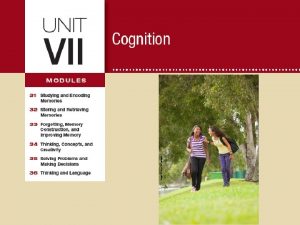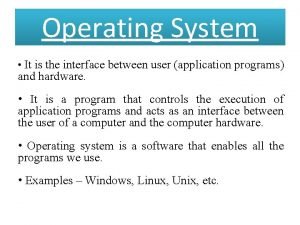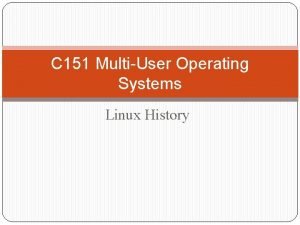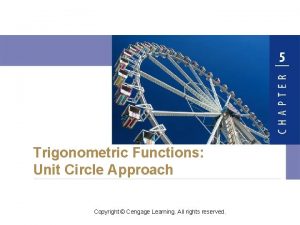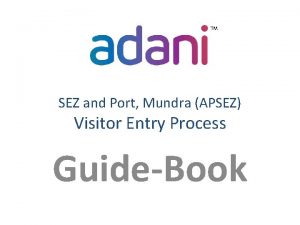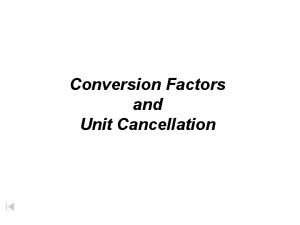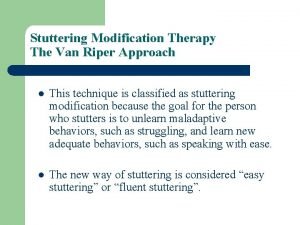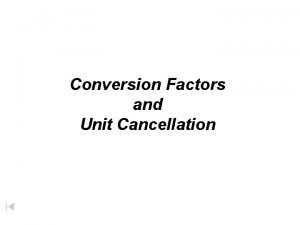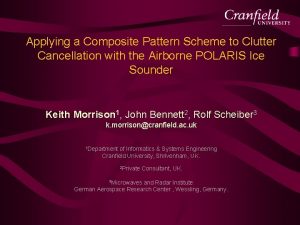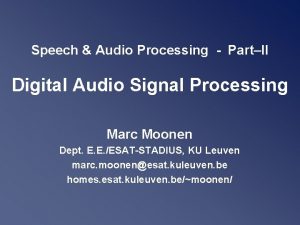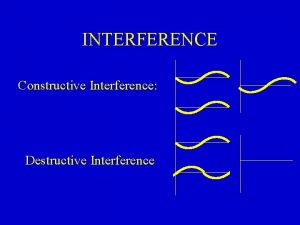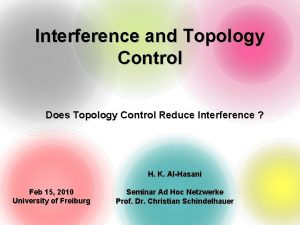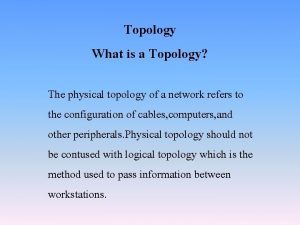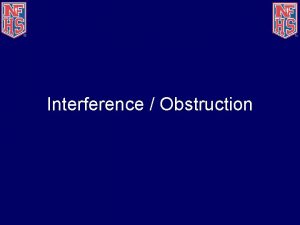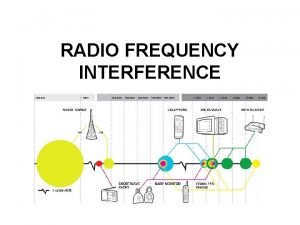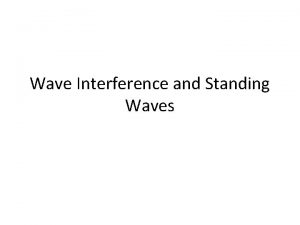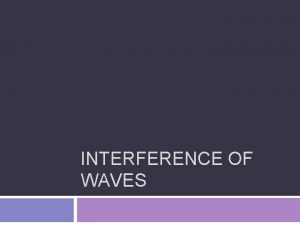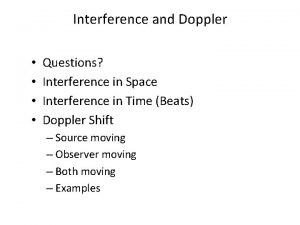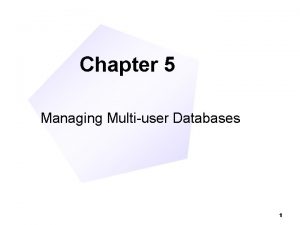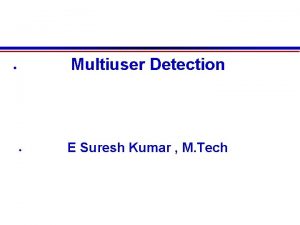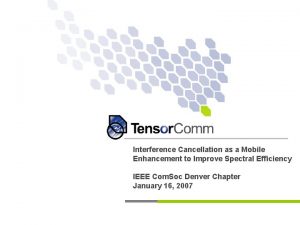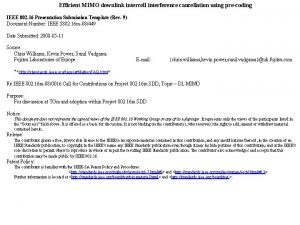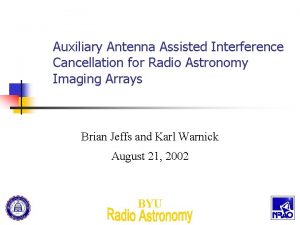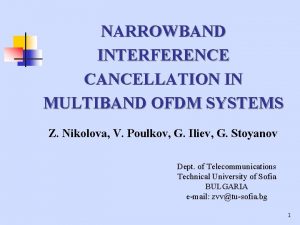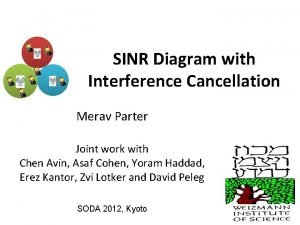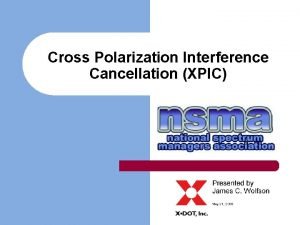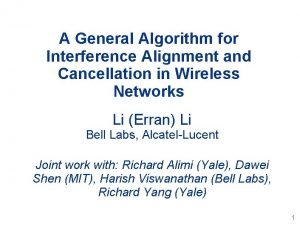Topology Control for Effective Interference Cancellation in MultiUser
























- Slides: 24

Topology Control for Effective Interference Cancellation in Multi-User MIMO Networks E. Gelal, K. Pelechrinis, T. S. Kim, I. Broustis Srikanth V. Krishnamurthy, B. Rao IEEE INFOCOM 2010

Problem Motivation & Contributions • MIMO communications are becoming prevalent w Multiple antenna elements robust links • 802. 11 n utilizes MIMO PHY w CSMA/CA no exploitation of MIMO capabilities Successive w At most one transmission each time instance Interference Cancellation • How can we realize multi-user MIMO communications? • Precoding techniques can be used w Accurate channel estimation, feedback from receiver. 2

Problem Motivation & Contributions • We design MUSIC (Multi-User MIMO with Successive Interference Cancellation) w Uses SIC for enabling Multi-user MIMO communications • Centralized and distributed approaches • Evaluation on a variety of settings w Our approach scales and the decoding error probability is bounded w MUSIC outperforms Do. F approaches. 3

Roadmap • Problem motivation & Contributions • Background • SIC w Problem formulation • Our approach • Evaluations • Conclusions 4

Background • Multi-user MIMO w Precoding techniques § § Tx sends pilot signals Rx receives pilot signals channel coefficients estimation Rx feedbacks channel coefficients to Tx Tx assigns weights at the antennas w Successive Interference Cancellation (SIC) § Receiver iteratively extracts high interfering signals § SINR requirement should be satisfied for every interferer. 5

Background • Selective diversity at Tx w Feedback from Rx to Tx for the best transmission element w One element used for subsequent transmission w Feedback is required less often than with precoding • Degrees of Freedom = k #antenna elements = k w k simultaneous transmissions are possible 6

Roadmap • Problem motivation & Contributions • Background • SIC w Problem formulation • Our approach • Evaluations • Conclusions 7

SIC • Spatial multiplexing enables multi-user MIMO with SIC Node 4 Node 3 SIC tries to remove first the stronger interferers and then decode the weaker intended signal. Node 2 Node 1 SIC 8

Models • Selection diversity and SIC • Two kinds of interferers w Strong: signal strength higher than the intended w Weak: signal strength weaker than the intended • Path loss and multipath w htr follows Rayleigh distribution, α is the path exponent, P the transmission power 9

Dealing with Weak Interferers • Maximum weak interference tolerated on link (u, v): • We want to assure that: • Assuming all interferers at the same distance as of the strongest one Aggregate weak interference follows Erlang distribution with parameters w n: number of intreferers w σ: variance of the Rayleigh distributed variable h 10

Dealing with Strong Interferers Strongest interferer P 1 Second strongest interferer P 2 d. Bm P 1/(N+P 2+P 3+…. +Pk) > γ P 2/(N+P 3+P 4+…. +Pk) > γ … Intended signal ((k-1) strongest) Pk-1/(N+Pk) > γ k stronger interferer (weak) PSUCCESFUL DECODING !! k Compact rule: Iteratively for correct decoding on link (y, z), there must be at most one interferer u, with the following interfering power: 11

Problem Formulation • Interference Graph, w Directed, edge and vertex weighted w V’ : set of links, with weight the mean value of the received signal strength w E’ : set of directed edges among the links/vertices, with weight the mean value of interference among the links connected. u v x y a(x, y) Pxy Pxv Puy b(u, v) Puv 12

Problem Formulation Time Slot 1 Time Slot 2 V 1’ links V 2’ links. . . Time Slot m Vm’ links • V 1’ V 2 ’ … V k’ = V ’ • TDMA scheme w In every time slot: ALOHA – like access with probability of failure at most δ. • Objective: minimize m NP - Hard 13

Roadmap • Problem motivation & Contributions • Background • SIC w Problem formulation • Our approach • Evaluations • Conclusions 14

C-MUSIC • The centralized algorithm is iterative. • Global knowledge of the topology • Main steps w Priority to links not scheduled w Include links that do not require SIC for decoding w Add links that can be decoded with SIC w Try to pack more links among those already scheduled 15

C-MUSIC • Two interfering links cannot belong to the same subtopology if: u u The weak interferer causes more interference than the weak interference budget The strong interference cannot be removed The two links have the same transmitter (selection diversity) A node is the transmitter for one of the links and a receiver for the other. 16

D-MUSIC Transmitter Receiver Overhearing Nodes 17

Roadmap • Problem motivation & Contributions • Background • SIC w Problem formulation • Our approach • Evaluations • Conclusions 18

Simulation Set Up OPNET simulations Traffic load: 10 -30 pkt/sec, 1500 bytes packets Path loss (α=4) and Rayleigh fading Simulations with different w Node density, SINR requirement, number of antenna elements • Metrics of interest: w Number of time slots, average decoding success probability, throughput • • • Comparison with: w Optimal (small topologies), Do. F based topology control 19

Evaluation results • MUSIC is efficient in terms of number of time slots formed Optimal C-MUSIC D-MUSIC 7. 83 9. 18 9. 64 • Density does not significantly decrease the probability of successful decoding 20

Evaluation results • Do. F based link activation cannot effectively exploit the benefits of multi-user MIMO w Do. F-based link activation leads to more decoding errors w MUSIC provides better throughput as compared with Do. F 21

Roadmap • Problem motivation & Contributions • Background • SIC w Problem formulation • Our approach: C-MUSIC • Evaluations • Conclusions 22

Conclusions • Identify the conditions for SIC to allow multi-packet reception in multi-user MIMO settings. • Design a framework for exploiting SIC • Demonstrate through simulations the applicability of our approach 23

THANK YOU ! QUESTIONS? 24
 Proactive interference vs retroactive interference
Proactive interference vs retroactive interference Source amnesia
Source amnesia Interface between user and hardware
Interface between user and hardware Xuml
Xuml Multiuser operating system
Multiuser operating system Trig cancellation property
Trig cancellation property Adani port entry pass
Adani port entry pass Gst suo moto cancellation revoke
Gst suo moto cancellation revoke Cancellation of units
Cancellation of units Van riper approach to stuttering
Van riper approach to stuttering Pcda dts
Pcda dts Unit cancellation
Unit cancellation Clutter cancellation
Clutter cancellation Absa home loan payment holiday
Absa home loan payment holiday Feature engineering
Feature engineering Keralartconline. com
Keralartconline. com Acoustic echo cancellation challenge
Acoustic echo cancellation challenge Pgl cancellation policy
Pgl cancellation policy Explorica tours
Explorica tours Kontinuitetshantering
Kontinuitetshantering Novell typiska drag
Novell typiska drag Nationell inriktning för artificiell intelligens
Nationell inriktning för artificiell intelligens Returpilarna
Returpilarna Varför kallas perioden 1918-1939 för mellankrigstiden?
Varför kallas perioden 1918-1939 för mellankrigstiden? En lathund för arbete med kontinuitetshantering
En lathund för arbete med kontinuitetshantering

